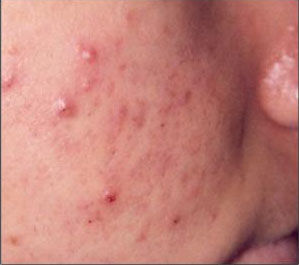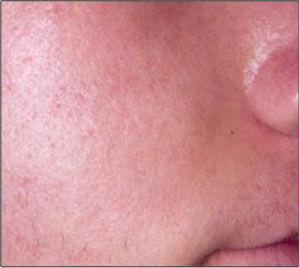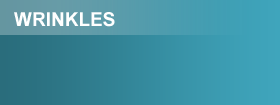Photodynamic TherapyWhat is Levulan Photodynamic Therapy?
IPL (Intense Pulsed Light) is combined with a topical medication called Levulan in a procedure known as Levulan Photodynamic Therapy (PDT). Photodynamic therapy for acne, precancerous sun spots and other uses, involves the application of Levulan ( 5-aminolevulinic acid), a medication that increases the skin's sensitivity to light. The Levulan is then activated with IPL which contains many wavelengths of light including 'blue light'.
Photodynamic Therapy (PDT) is also known as 'ALA/PDT treatment'.
Sun damage, fine lines, and blotchy pigmentation are also improved due to the positive effects of this treatment. ALA/PDT treatment also has the unique ability to minimize pores and reduce oil glands, effectively treating stubborn acne, rosacea, and improve the appearance of some acne scars.
What is IPL?
Intense Pulsed Light (IPL) also known as photo-facial, fotofacial, and photo rejuvenation is a state-of-the-art system and the latest technique in photofacial therapy. The IPL system delivers high intensity, smooth and powerful pulses of light (not lasers) that greatly enhances the results of your skin rejuvenation. For skin therapy, IPL stimulates new collagen growth resulting in smoother, more even, healthier skin. IPL contains many wavelengths of light energy including 'blue light'.
What is Levulan?
Levulan (5-Amino Levulinic Acid) is a medication that is applied to the skin. This medication makes the skin more sensitive to sunlight and the IPL treatments.
What is Blue Light?
Blue light is an alternative light source that can be used instead of IPL to activate the Levulan. It is our experience that IPL , which contains 'blue light', produces a better result so that we recommend the Levulan IPL combination to our Photodynamic therapy patients.
Can Levulan Photodynamic therapy be used to treat acne?
Yes. This results in significant improvement in moderate to severe cystic acne.
Acne is a common, chronic skin condition caused by inflammation of oil-producing sebaceous glands. Acne usually begins between the ages of ten and thirteen, and persists for five to ten years. Acne breakouts are most common on the face, but they can also occur on the back, shoulders, neck, chest, scalp, upper arms and legs.
Young men and women get acne in equal numbers. Younger males are more prone to severe, longer-lasting forms of the skin condition. Many women suffer from 'hormonal acne' - their outbreaks are tied to the hormonal changes related to their menstrual cycle. While hormonal acne typically starts between the ages of 20-25, it can strike teenagers as well. Hormonal acne is sometimes persistent in women in their 30s.
While not life threatening, acne can leave life-long emotional and physical scars - a reminder of the embarrassment and self-consciousness that came with the pimples. No one wants to get zits.
Approximately 90% of all adolescents and 25% of all adults experience acne at some point in their lives. It's one of the most extensive medical conditions in the world, and is responsible for about 30% of all visits to the dermatologists. Acne can be treated with topical creams and lotions, birth control pills, antibiotic pills, glycolic peels and microdermabrasion. Now PDT is another safe and effective alternative available for acne treatment.
IPL Levulan Photodynamic acne treatment involves three mechanisms of action against acne. Levulan treatment inactivates the bacteria that trigger acne, exfoliates the skin to unclog pores, and shuts down the oil glands (sebaceous glands) in the skin. This can produce long-lasting improvement.
Levulan acne therapy can even work in patients who have failed Accutane. Levulan is a very safe alternative to Accutane treatment.
Results with Levulan PDT are especially impressive when compared with conventional treatments, such as topical medicines and oral antibiotics.
Can Levulan Photodynamic Therapy be used to treat freckles and skin pigmentation?
Yes.
They might have been cute when you were younger, but those freckles you have now probably aren't as attractive as they once were. Even more, they are actually signs of sun-damaged skin.
All those years at the beach add up, even if you can't see the damage it has caused. Many people believe that if they apply a bit of sunscreen and they don't peel, they're not at risk for sun damage or skin cancer. However, a UV camera proves this theory wrong.
The skin's pigment, called melanin, only absorbs certain UV light waves. If we filter out the waves that are not absorbed, we can see the melanin. By using a special UV camera that removes the extra light waves, we are able to show the dark blotchy spots called hyperpigmentation, which indicates UV damaged skin. You'd be surprised how much damage even children and young people have.
PDT is a safe and efficient way to reduce and improve freckling.
Can Levulan Photodynamic Therapy be used for skin rejuvenation and improvement of sun damage?
Yes. Levulan Photodynamic Therapy using intense pulsed light (IPL) is now the gold standard for non-surgical skin rejuvenation. This procedure results in significant improvement in precancerous conditions such as actinic keratoses, sun damaged skin and potentially superficial skin cancers. Additionally it improves wrinkles, pore size, skin texture, pigmentation, rosacea, sebaceous hyperplasia (oil gland enlargement), and potentially prevents the development of skin cancer. Levulan is revolutionizing how we perform skin rejuvenation and how we treat sun-damaged skin.
What else can Levulan Photodynamic Therapy be used for?
Removing precancerous skin lesions
Preventing skin cancer
Improving wrinkles
Improving pores
Improving skin texture
Improving pigmentation
Treating moderate to severe cystic acne
Treating sebaceous hyperplasia
What is the procedure for Levulan Photodynamic therapy?
1. An IPL Photodynamic Therapy technician will apply the medicine, which is a clear solution, to freshly cleansed skin. After a period of 30-60 minutes, the area is illuminated with an appropriate light source. This 30-60 minute application time is termed the incubation period. Short incubation times retain efficacy but diminish discomfort and side effects. There is normally NO discomfort to the patient with short incubation times and 8-10 minutes of blue light therapy or IPL activation.
2. The therapy is suitable to treat all areas of the body, including the back, chest and face.
3. After the incubation period the Levulan will be activated with IPL (Intense Pulsed Light).
4. You may be given an anaesthetic topical cream applied prior to the light exposure.
5. You will be given special goggles to wear to protect your eyes during the treatment.
6. During the treatment you may feel stinging, tingling, prickling, or burning of the lesions, but this should go away after the treatment.
7. You should stay out of the sun and bright light as much as possible for the next 48 hours because the treated lesions are sensitive to light. Going into bright light or sunlight runs the risk of getting redness, stinging, burning sensation in the skin, swelling or even a severe burn. Patients should protect treated lesions from the sun by wearing a wide-brimmed hat or similar head covering of light-opaque material. Sunscreens will NOT protect against photosensitivity reactions caused by visible light. However, opaque sun-blocking agents such as zinc oxide will provide some protection in the first 24 hours.
8. After treatment with the IPL, the solution should be washed off the skin using soap and water following the light activation.
9. After a normal treatment the skin will become red and swollen in the following 3-7 days
10. Some crusting may be noted and is normal.
11. There should be some discomfort, but no significant pain.
12. After 1 week, there might be some residual redness that will subside after a few days and can be covered with make up.
13. You can return to normal activities immediately after treatment, as long as you avoid bright light and sunlight for 48 hours.
Who should not have PDT (Levulan Photodynamic Therapy) treatments?
You should not be treated if you have:
1. Skin sensitivity to blue light
2. Porphyria (a disorder of the metabolism that can lead to sensitivity to light)
3. Allergies to chemicals called porphyrins
What specific information should I know after I have had a Levulan PDT (Photodynamic Therapy) treatment?
I have included below the contents of information handouts provided to my patients following treatments for two separate concerns: Acne and Sundamage/Precanceous Sun Spots. Some of the content differs between them.
|
treatment for acne  Dr. Hester talks about Skin Care after Levulan PDT for Acne Dr. Hester talks about Skin Care after Levulan PDT for Acne
For the 48 hours after your Levulan PDT (Photodynamic Therapy) treatment:
1.
Keep the treated area out of the sun and bright lights for 48 hours.
Exposure to the sun within this time period can lead to a severe
blistering burn in the areas that were treated.
2. If outdoor
exposure sun is unavoidable, wear a hat with a brim, cover your face
with a scarf, wear large sunglasses and use Anthelios 60 sunscreen.
Sunscreen alone is NOT ENOUGH PROTECTION to prevent a burn in the first
48 hours after treatment.
3. You should continue to use sunscreen
daily for at least 4 weeks following treatment regardless of the time
of year or if it is overcast or cloudy. Sun exposure may lead to the
production of blotchy dark pigmentation which may take several months
to fade.
1. Avoid excessive heat exposure such as saunas, steam
rooms, hot showers or baths, and strenuous exercising for 24 hours.
This prevents the risk of blistering.
For the first week after Levulan PDT:
1. Avoid any aggressive skin care products such as scrubs, exfoliants, alpha or beta hydroxy acid products.
2. Keep clothing from rubbing the treated area and avoid other irritation to the area.
3. Do not get hairspray on the treated area.
4. Notify the office should you have any prolonged redness, excessive puffiness, or other unusual side effects.
What should I expect after my treatment?
1.
There will be redness, and occasionally, mild blistering or bruising of
the treated areas lasting from several hours to 3-14 days. This will
depend on the sensitivity of your skin and the severity of your acne.
Most people are completely healed within 7 days.
2. The treated area
might "crust", "flake", or look like a "cat scratch." Some crusting and
scabbing is considered a good result. This should resolve within 3-14
days.
3. Each area is usually treated every 3 weeks or more, for 3
or 4 treatments. Treatment can be repeated in the future if desired.
4. It might be impossible to "cure" your acne, although most patient get significant improvement with this treatment.
5. Your skin will be more sensitive for a few days up to a couple of weeks after your treatment.
Skin Care Regimen - immediately after and between treatments:
Morning
1.
Step 1 - To cleanse your skin, apply a small amount of Milk Cleanser to
clean your skin. Use a soft cloth to remove it. You may use lukewarm
water with it.
2. Step 2 - Gently mist La Roche Posay Eau Thermale
(Thermal Water) on the treated area. The antioxidant and anti-irritant
properties of the water will help calm the redness and promote healing.
3. Step 3 - Apply moisturizer to area treated to reduce redness from treatment.
4.
Step 4 - *Important* Apply sunscreen to the treated areas 20 minutes
before going outside, every day for 4 weeks. Use it even if there is
little or no sunshine out.
5. Step 5 - Apply foundation/make-up
Evening
1. Repeat steps 1 through 3.
Skin Care Regimen - starting TWO WEEKS AFTER your LAST TREATMENT
Morning
1.
Step 1 - To cleanse your skin, apply a small amount of Effaclar Gel
Cleanser to clean your skin. Use a soft cloth to remove it. You may use
lukewarm water with it.
2. Step 2 - Use toner over your face, avoiding your eyelids, eyes and lips.
3.
Step 2 - Gently mist La Roche Posay Eau Thermale (Thermal Water) over
your face. The antioxidant and anti-irritant properties of the water
will help calm the redness and promote healing.
4. Step 4 - Apply
sunscreen to the treated areas 20 minutes before going outside, every
day. Use it even if there is little or no sunshine out.
5. Step 5 - Apply foundation/make-up
Evening - starting TWO WEEKS AFTER your LAST TREATMENT
1. Repeat steps 1 through 3.
2. Step 4 - Apply Effaclar K moisturizer to your face.
Remember on The Day of Your Next Treatment
1.
You must not be tan coming in for your treatment. Treating skin with a
tan can produce white "striping" which can take several months to fade.
Your skin MUST NOT BE TANNED.
2. Stop the use of all Retin-A products and toners a week before your treatment.
3. You must avoid sun exposure for 48 hours after your treatment to avoid blistering.
All of the products that I recommend are available in my office for your convenience.
Dr. Hester talks about Skin Care after Levulan PDT for Sun Damage and Precancerous Sun Spots (Actinic Keratoses)
For the 48 hours after your Levulan PDT (Photodynamic Therapy) treatment for sun damage and precancerous sun spots:
1.
Keep the treated area out of the sun and bright lights for 48 hours.
Exposure to the sun within this time period can lead to a severe
blistering burn in the areas that were treated.
2. If outdoor
exposure sun is unavoidable, wear a hat with a brim, cover your face
with a scarf, wear large sunglasses and use Anthelios 60 sunscreen.
Sunscreen alone is NOT ENOUGH PROTECTION to prevent a burn in the first
48 hours after treatment.
3. You should continue to use sunscreen
daily for at least 4 weeks following treatment regardless of the time
of year or if it is overcast or cloudy. Sun exposure may lead to the
production of blotchy dark pigmentation which may take several months
to fade.
1. Avoid excessive heat exposure such as saunas, steam
rooms, hot showers or baths, and strenuous exercising for 24 hours.
This prevents the risk of blistering.
For the first week after Levulan PDT:
1. Avoid any aggressive skin care products such as scrubs, exfoliants, alpha or beta hydroxy acid products.
2. Keep clothing from rubbing the treated area and avoid other irritation to the area.
3. Do not get hairspray on the treated area.
4. Notify the office should you have any prolonged redness, excessive puffiness, or other unusual side effects.
What should I expect after my treatment?
1.
There will be redness, and occasionally, mild blistering or bruising of
the treated areas lasting from several hours to 3-14 days. This will
depend on the sensitivity of your skin and the severity of your sun
damage. Most people are completely healed within 7 days.
2. The
treated area might "crust", "flake", or look like a "cat scratch." Any
areas that become crusted are pre-cancerous areas that have been
successfully treated. Some crusting and scabbing is considered a good
result. This should resolve within 3-14 days.
3. Each area is usually treated once or twice, 3 weeks or more apart. Treatment can be repeated every 6 to 12 months.
4.
It might be impossible to remove a lesion forever or get permanent
results. Even though a lesion may be diminished or "disappear" for long
periods of 3-6 months, it might return in the future. If a lesion
recurs, show it to the doctor.
5. Your skin will be more sensitive for a few days up to a couple of weeks after your treatment.
Skin Care Regimen - immediately after treatment and between your treatments
Morning
1.
Step 1 - To cleanse your skin, apply a small amount of Milk Cleanser to
clean your skin. Use a soft cloth to remove it. You may use lukewarm
water with it.
2. Step 2 - Gently mist La Roche Posay Eau Thermale
(Thermal Water) on the treated area. The antioxidant and anti-irritant
properties of the water will help calm the redness and promote healing.
3. Step 3 - Apply moisturizer to area treated to reduce redness from treatment.
4.
Step 4 - *Important* Apply sunscreen to the treated areas 20 minutes
before going outside, every day for 4 weeks. Use it even if there is
little or no sunshine out.
5. Step 5 - Apply foundation/make-up
Evening
1. Repeat steps 1 through 3.
Remember on The Day of Your Next Treatment
1.
You must NOT be tanned when you come in for your Levulan PDT treatment
. Treating skin with a tan can produce white "striping" which can take
several months to fade. Your skin MUST NOT BE TANNED.
2. Stop the use of all Retin-A products and toners a week before your treatment.
3. You must avoid sun exposure for 48 hours after your treatment to avoid blistering.
|


























